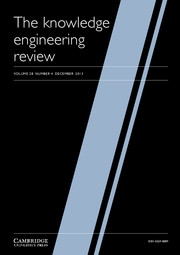Crossref Citations
This article has been cited by the following publications. This list is generated based on data provided by
Crossref.
Meynell, Letitia
2013.
Parsing pictures: on analyzing the content of images in science.
The Knowledge Engineering Review,
Vol. 28,
Issue. 3,
p.
327.
Frappier, Mélanie
Meynell, Letitia
and
Brown, James Robert
2013.
Special issue on visual representations and reasoning.
The Knowledge Engineering Review,
Vol. 28,
Issue. 3,
p.
231.
Kaiser, Marie I.
2015.
Reductive Explanation in the Biological Sciences.
p.
43.
Sidiropoulos, Konstantinos
Viteri, Guilherme
Sevilla, Cristoffer
Jupe, Steve
Webber, Marissa
Orlic-Milacic, Marija
Jassal, Bijay
May, Bruce
Shamovsky, Veronica
Duenas, Corina
Rothfels, Karen
Matthews, Lisa
Song, Heeyeon
Stein, Lincoln
Haw, Robin
D’Eustachio, Peter
Ping, Peipei
Hermjakob, Henning
Fabregat, Antonio
and
Kelso, Janet
2017.
Reactome enhanced pathway visualization.
Bioinformatics,
Vol. 33,
Issue. 21,
p.
3461.
Lynteris, Christos
2017.
Zoonotic diagrams: mastering and unsettling human‐animal relations.
Journal of the Royal Anthropological Institute,
Vol. 23,
Issue. 3,
p.
463.
Galano, Silvia
Colantonio, Arturo
Leccia, Silvio
Marzoli, Irene
Puddu, Emanuella
and
Testa, Italo
2018.
Developing the use of visual representations to explain basic astronomy phenomena.
Physical Review Physics Education Research,
Vol. 14,
Issue. 1,
Jupe, Steve
Ray, Keith
Roca, Corina Duenas
Varusai, Thawfeek
Shamovsky, Veronica
Stein, Lincoln
D'Eustachio, Peter
and
Hermjakob, Henning
2018.
Interleukins and their signaling pathways in the Reactome biological pathway database.
Journal of Allergy and Clinical Immunology,
Vol. 141,
Issue. 4,
p.
1411.
Morgan, Mary S.
2020.
Inducing Visibility and Visual Deduction.
East Asian Science, Technology and Society: An International Journal,
Vol. 14,
Issue. 2,
p.
225.
Ambrosio, Chiara
2020.
Toward an Integrated History and Philosophy of Diagrammatic Practices.
East Asian Science, Technology and Society: An International Journal,
Vol. 14,
Issue. 2,
p.
347.
Sartori, Lorenzo
2023.
Putting the ‘Experiment’ back into the ‘Thought Experiment’.
Synthese,
Vol. 201,
Issue. 2,
Meynell, Letitia
2023.
The Scientific Imagination: Philosophical and Psychological Perspectives, edited by Arnon Levy and Peter Godfrey-Smith.
Mind,
Vol. 132,
Issue. 527,
p.
927.
Taylor, Holly A.
Burte, Heather
and
Renshaw, Kai T.
2023.
Connecting spatial thinking to STEM learning through visualizations.
Nature Reviews Psychology,
Vol. 2,
Issue. 10,
p.
637.

